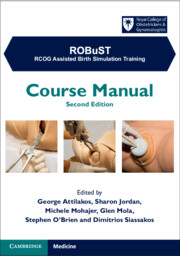Book contents
- ROBuST
- Reviews
- ROBuST
- Copyright page
- Contents
- Contributors
- Preface
- Acknowledgements
- Abbreviations
- Chapter 1 Trends in Assisted Vaginal Birth and Future Practice
- Chapter 2 Indications and Assessment for Assisted Vaginal Birth
- Chapter 3 Non-technical Skills
- Chapter 4 Vacuum-Assisted Birth
- Chapter 5 Non-Rotational forceps and Manual Rotation
- Chapter 6 Rotational Forceps
- Chapter 7 Caesarean Section at Full Cervical Dilatation
- Chapter 8 Medico-Legal Aspects of Assisted Vaginal Birth (AVB)
- Chapter 9 Analgesia and Anaesthesia for Assisted Vaginal Birth
- Index
- References
Chapter 2 - Indications and Assessment for Assisted Vaginal Birth
Published online by Cambridge University Press: aN Invalid Date NaN
- ROBuST
- Reviews
- ROBuST
- Copyright page
- Contents
- Contributors
- Preface
- Acknowledgements
- Abbreviations
- Chapter 1 Trends in Assisted Vaginal Birth and Future Practice
- Chapter 2 Indications and Assessment for Assisted Vaginal Birth
- Chapter 3 Non-technical Skills
- Chapter 4 Vacuum-Assisted Birth
- Chapter 5 Non-Rotational forceps and Manual Rotation
- Chapter 6 Rotational Forceps
- Chapter 7 Caesarean Section at Full Cervical Dilatation
- Chapter 8 Medico-Legal Aspects of Assisted Vaginal Birth (AVB)
- Chapter 9 Analgesia and Anaesthesia for Assisted Vaginal Birth
- Index
- References
Summary
The decision whether or not to recommend an assisted vaginal birth (AVB) is a complex one. Decision-making about the most appropriate mode of birth needs to take account of the key elements for a safe AVB which are that it needs to be conducted under optimal circumstances, in the most appropriate place and by a competent operator. Safety issues need to be balanced with the aim of providing a positive birth experience for the mother and her partner. The risks of maternal and neonatal morbidity are increased with AVBs, although with appropriate case selection and careful practice these risks are low. Careful attention needs to be paid to the indication for AVB and to clinical assessment prior to any attempt at a procedure.
- Type
- Chapter
- Information
- ROBuST: RCOG Assisted Birth Simulation TrainingCourse Manual, pp. 10 - 23Publisher: Cambridge University PressPrint publication year: 2024



